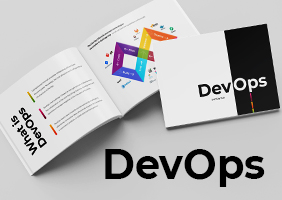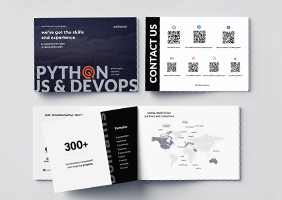What’s cloud computing first of all?
Cloud computing is a type of software service provision presupposing the use of the Internet to access the remote servers enabling users to store, access and share data and resources without having to maintain a physical machine. This type of software delivery service is often opposed to the rather old-fashioned usage of local servers or personal computers which is now slowly becoming obsolete. Cloud services are commonly provided by the third-party vendors, most well-known being Amazon with their AWS platform, Google providing us all with GCP, Microsoft and their Windows Azure.
The advantages of cloud computing
 All these technologies sound really familiar to us, don’t they? Each of us, our friends and relatives, small local businesses and huge enterprises - everyone is now actively using the benefits of cloud computing both in daily life and at work. Just to consider a few of them, we suggest the list of our top advantages of making a move towards cloud technologies.
All these technologies sound really familiar to us, don’t they? Each of us, our friends and relatives, small local businesses and huge enterprises - everyone is now actively using the benefits of cloud computing both in daily life and at work. Just to consider a few of them, we suggest the list of our top advantages of making a move towards cloud technologies.
Data security
One of the major user concerns is how secure their information can be when hosted on a remote server which can be shared by other users and connected to a whole network of other servers. Own physical server might seem to be a better choice in this case - only at first glance. Enought to mention some possible on-premise threats like employee loss, theft of data or computing assets.
In reality, a number of security measures are taken by the cloud hosting vendors to prevent data loss and ensure a safe computing environment in the multi-tenant infrastructure. These include access restrictions to apps and system resources, logging, monitoring and control of access and use of apps and systems, employment of security architecture models with app-level configurations, as well as the implementation of baseline protections like user authentication, encryption, SSO, API controls contracts and so on.
What is more, apart from these precautions offered by the widely adopted public cloud, one may resort to even more secure private or dedicated cloud - a single-tenant infrastructure using an isolated server per each individual customer and secured by a network firewall. This option can be more costly, but will definitely ensure the maximal level of control over your data, apps and systems. It is exceptionally important for businesses working with sensitive data or proprietary information.
Scalability
Using the on-premise server collection can be like buying clothes you’ll never wear: first, you thought you’d need it but it turned out to be unfitting. And now you don’t know what to do with it. Or, in case of rapid growth, you suddenly realize you need some extra storage and capacity right now, but you have to take extra time and effort to build and set up a new server infrastructure. This problem can be easily eliminated due to cloud services.
Whenever you need flexibility in computer capacity and storage, moving to the cloud will be an ideal choice. On-demand cloud computing platforms providing their services on a pay-as-you-go basis allow their customers to use as many resources as needed at a particular moment. This enables businesses with fluctuating bandwidth needs and varying workload to quickly and effectively scale up or down paying for the exact amount of server space and resources used. This is also a great benefit for small businesses that are planning to grow quickly or aren’t sure exactly how much resources they might need for their functioning.
Success story: How the Australian government benefits from cooperating with AWS.
Mobility and availability
As it often happens with desktop applications or files located on your hard drive, you desperately need to access them at the worst possible moment - when you don’t have this particular device with you. Especially when it comes to pressing work issues - who hasn’t tried doing their job remotely.
The cloud service providers take care to make your personal or corporate data available for you 24/7 provided you remember your credentials and have access to any computer device with a stable Internet connection (which is really not a problem these days). This way, you can stay up-to-date on important issues instantly, easily store, retrieve, recover and process your data anytime and anywhere. Also, remote data access gives the opportunity for teams and colleagues to collaborate on a single shared project, without creating multiple copies of any document, no matter which part of the world each of them is located in. And you don’t need to have files in your device memory any more to share them with people - just send data as web links to your target recipients to download from.
Less trouble
As Murphy’s law goes, anything that can go wrong - will go wrong. If you are using any in-house hardware that looks at least a bit more advanced than a regular laptop, you definitely need a team of IT professionals to handle all the possible issues arising from it.
Unlike using the physical servers, cloud computing, from the admin point of view, is fairly easy to manage and, the best part about it, cloud service providers take the responsibility for maintaining their systems, ensuring the proper levels of performance, security and control, as well as managing all the forthcoming updates and potential threats off-sight. Isn’t it amazing?
Remote data backup/Disaster recovery
Everybody knows how it feels when important information is lost due to possible malware, hardware crashes or deterioration, a simple user error or a lame power cut, and even a natural disaster. That’s what you may be expecting when using physical on-premise servers to store your own or your client’s data. Such troubles may cost you your company revenues, brand positioning, customer loyalty and trust.
With the cloud services, however, you can be pretty certain about your data backup and disaster retrieval opportunities. On the remote servers, the data is arranged and stored on multiple servers in the network. A reserve copy of your files is made instantly and transferred to a secondary, off-site location regularly by the provided settings or as soon as data updates take place.
Cost efficiency
Compared to having your own physical servers, using cloud services might seem more expensive. Although having taken into account everything said before, the benefits of cloud computing significantly outweigh the costs. In addition, moving to the cloud helps companies to avoid some extra expenses like capital investment in hardware, IT staff salary, rent for a bigger office with a server room, and even electricity bills (yes, physical servers and air conditioners for them are pretty power-hungry).
What kind of products can be used in the cloud?
There is a number of cloud computing vendors out there, the most popular being Amazon, Microsoft, Google, IBM, Salesforce and VMware. Each of them offers a range of cloud services based on three main delivery models that are known to the wide audience as IaaS (Infrastructure-as-a-Service), PaaS (Platform-as-a-Service) and SaaS (Software-as-a-Service). Let’s take a closer look at these cloud service types.
Infrastructure-as-a-Service - IaaS
In other words, this is a cloud-based alternative to an on-premise data center for software developers. These web services provide users with virtual machines having the required storage and capacity as well as networking, monitoring, security and load balancing opportunities. The users are then given freedom to install any preferred operating system, tools and applications to run their work.
IaaS typically include such products as remote servers for storage, operating systems, virtual machines and networks. The most well-known examples of IaaS can be Amazon Web Services (AWS), Elastic Compute Cloud (EC2), Microsoft Azure, Google Compute Engine (GCE).
Platform-as-a-Service - PaaS
Designed to work as B2B solutions, PaaS actually provides a software development framework and tools for IT engineers to build, test and maintain custom web applications. It is especially valued in microservices architecture of application development. In contrast to IaaS, PaaS allows users to forget about managing the operating system, updates, middleware and runtime, and to stay more focused on coding and running their apps. This service model may have some limitations like programming language restriction or support the insufficient list of development tools, but, on the other hand, it brings much simplicity and convenience into the work of those who have attentively considered the PaaS provider’s service roadmap.
PaaS providers may offer such solutions as AWS Elastic Beanstalk, Salesforce Lightning Platform or Google App Engine which allow build, deploy and scale own web applications.
Read more about PaaS delivered by Quintagroup here.
Software-as-a-Service - SaaS
SaaS is delivered to its target users as completely functional web applications and may perfectly fit any business cooperation model - B2B, B2G or B2C - as well as any business industry. SaaS solutions are managed entirely by their providers, making them the best choice for those who don’t have enough resources or need to hire additional IT staff and would like to avoid physical software download and installation to their computers.
Nowadays, most software we use on a daily basis is delivered to us with the SaaS model - just consider the streaming services like Netflix, chatbots like Siri or Google Assistant, messengers like Telegram or Skype, office tools like Google Docs, numerous CRM and ERP applications like Salesforce, backup solutions like Dropbox and Amazon S3, big data tools like Hadoop and Cassandra, and, of course, our favourite social networking from Facebook, LinkedIn and many others.
Follow this link to learn about SaaS delivered by Quintagroup.
Once you’ve considered the obvious pros of moving your business operations to the cloud, and have learned about the cloud service delivery models, you might wonder what you can do to start taking advantage of cloud computing. Well, this article has the answer to this question either.
How to start using cloud services?
Generally speaking, deciding on your business or personal needs should be enough for you to make a decision as to which cloud service delivery model to choose.
The Quintagroup company has a longstanding experience in web application development and delivery, so our experts are always open to any related questions and discussions. All you need to do is to fill in this form, click the LET’S TALK button below or go to Services section to get more information.


